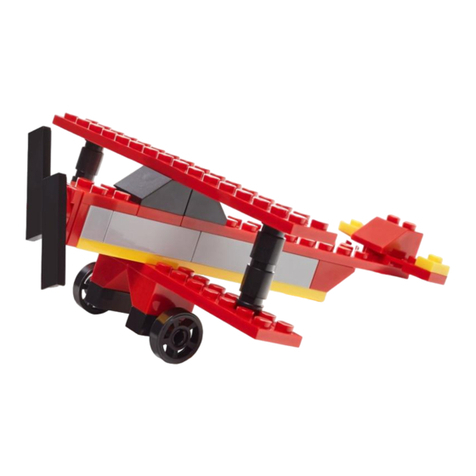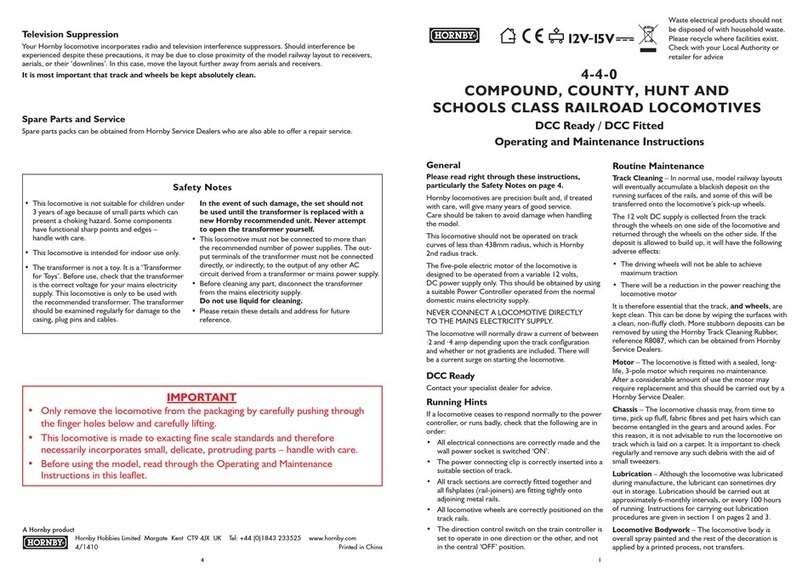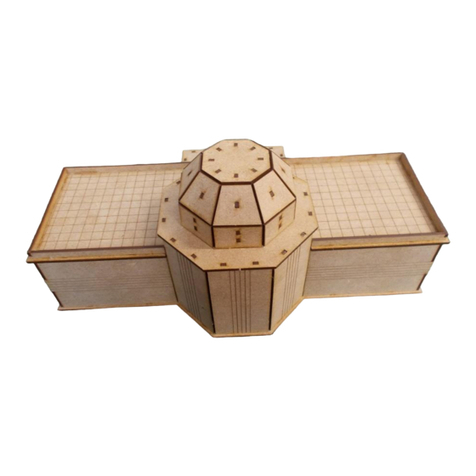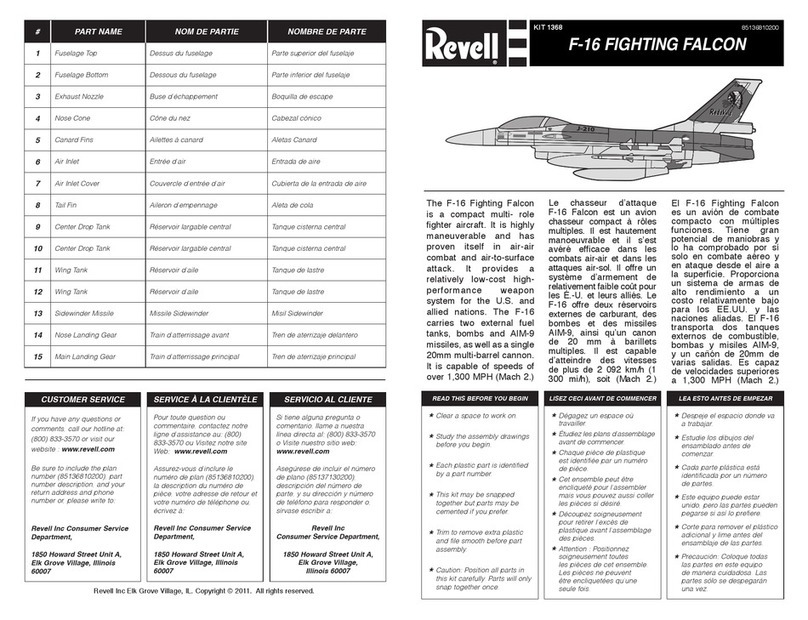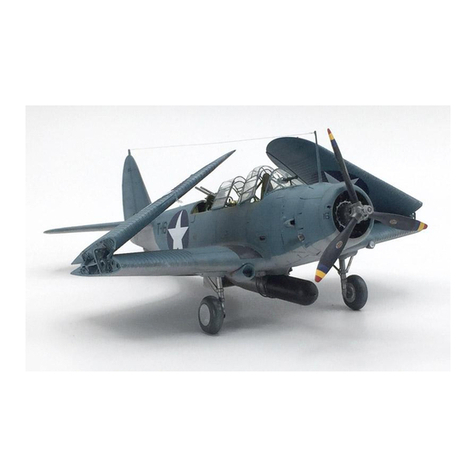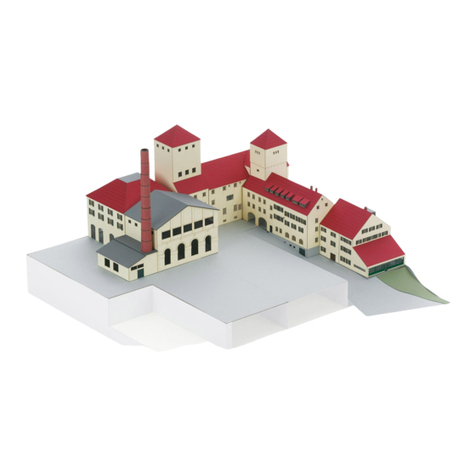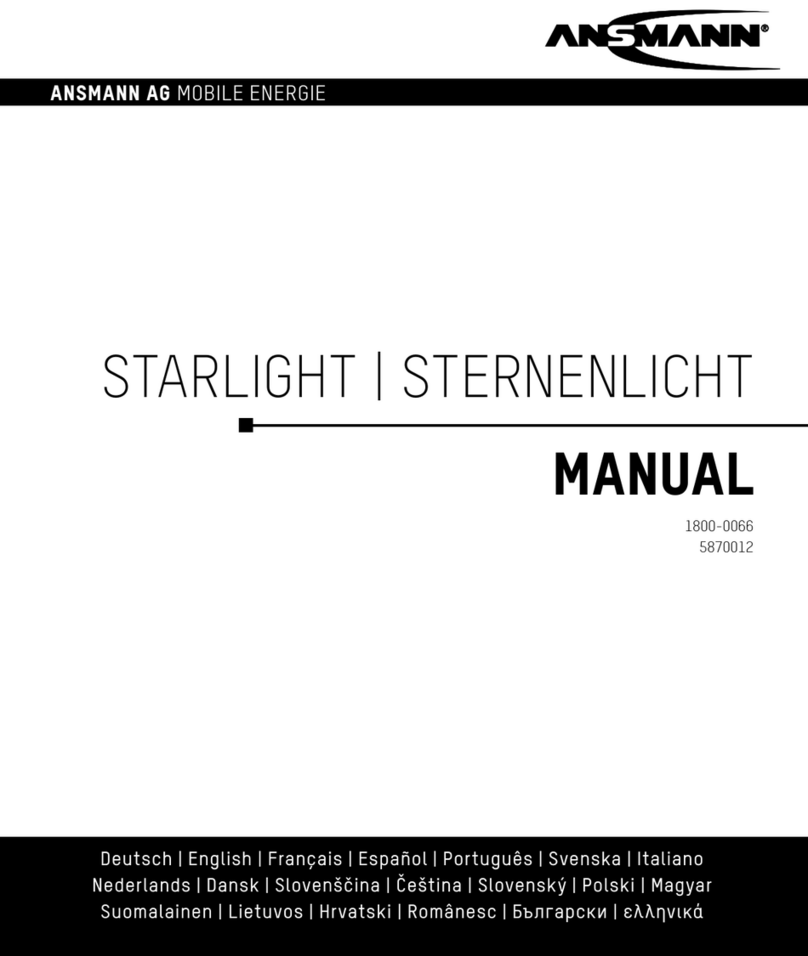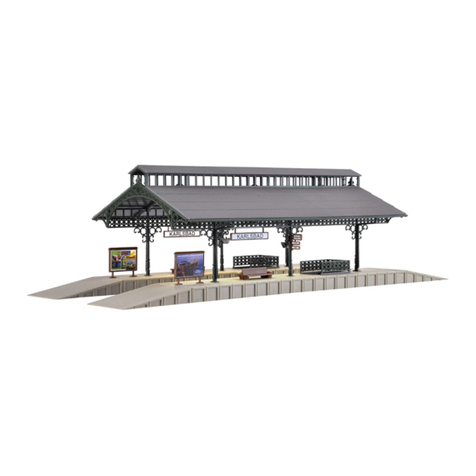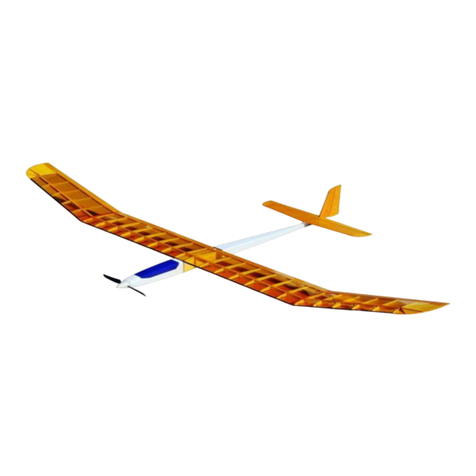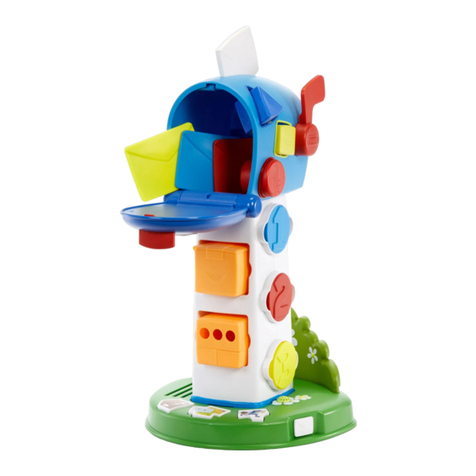electrifly PBY CATALINA User manual

Great Planes®Model Manufacturing Co. guarantees this kit to
be free from defects in both material and workmanship at the date
of purchase. This warranty does not cover any component parts
damaged by use or modification. In no case shall Great Planes’
liability exceed the original cost of the purchased kit. Further,
Great Planes reserves the right to change or modify this warranty
without notice.
In that Great Planes has no control over the final assembly or
material used for final assembly, no liability shall be assumed nor
accepted for any damage resulting from the use by the user of
the final user-assembled product. By the act of using the user-
assembled product, the user accepts all resulting liability.
If the buyer is not prepared to accept the liability associated
with the use of this product, the buyer is advised to return
this kit immediately in new and unused condition to the place
of purchase.
To make a warranty claim send the defective part or item to Hobby
Services at the address below:
Hobby Services
3002 N. Apollo Dr., Suite 1
Champaign, IL 61822 USA
Include a letter stating your name, return shipping address, as
much contact information as possible (daytime telephone number,
fax number, e-mail address), a detailed description of the problem
and a photocopy of the purchase receipt. Upon receipt of the
package, the problem will be evaluated as quickly as possible.
READ THROUGH THIS MANUAL BEFORE STARTING CONSTRUCTION. IT CONTAINS IMPORTANT
INSTRUCTIONS AND WARNINGS CONCERNING THE ASSEMBLY AND USE OF THIS MODEL.
Champaign, Illinois
(217) 398-8970, Ext 5
airsuppor[email protected]
WARRANTY
INSTRUCTION MANUAL
Entire Contents © Copyright 2007 GPMZ1154 for GPMA1154 V1.1
Wingspan: 53.5 in [1360mm]
Wing Area: 395 sq in [25.5dm2]
Weight: 3-3.25 lb [1360-1470g]
Wing Loading: 18-19 oz/sq ft [55-58 g/dm2]
Length: 34.25 in [870mm]
Radio: 4-Channel with Two Micro-Mini and Two Micro Servos
Motor: Two 28-30-950 RimFire™Brushless Motors and
Two ElectriFly SS-25 Speed Controls
™

2
TABLE OF CONTENTS
INTRODUCTION ............................................................... 2
AMA .................................................................................. 2
SAFETY PRECAUTIONS ................................................. 3
LITHIUM BATTERY HANDLING AND USAGE ................ 3
DECISIONS YOU MUST MAKE........................................ 3
Radio Equipment ....................................................... 3
Motor Recommendations........................................... 3
ADDITIONAL ITEMS REQUIRED .................................... 4
Adhesives and Building Supplies............................... 4
Optional Supplies and Tools....................................... 4
IMPORTANT BUILDING NOTES ...................................... 4
ORDERING REPLACEMENT PARTS .............................. 4
KIT CONTENTS................................................................ 5
PREPARATIONS............................................................... 6
ASSEMBLE THE WING .................................................... 6
ASSEMBLE THE FUSELAGE .......................................... 9
Install the Stab, Elevators and Rudder....................... 9
Install the Elevator & Rudder Servos & Pushrods.... 11
Install the Speed Control, Receiver & Batteries....... 12
FINAL ASSEMBLY ......................................................... 14
Complete the Radio Installation ............................... 14
Finishing Touches .................................................... 14
GET THE MODEL READY TO FLY ................................. 15
Install & Connect the Motor Battery ......................... 15
Set the Control Throws ............................................ 16
Balance the Model (C.G.)......................................... 16
Balance the Model Laterally..................................... 17
PREFLIGHT .................................................................... 17
Identify Your Model................................................... 17
Charge the Batteries ................................................ 17
Balance Propellers................................................... 17
Range Check ........................................................... 17
MOTOR SAFETY PRECAUTIONS ................................. 17
AMA SAFETY CODE...................................................... 18
CHECK LIST................................................................... 18
FLYING............................................................................ 19
Takeoff ..................................................................... 19
Flight ........................................................................ 19
Landing .................................................................... 19
INTRODUCTION
The PBY Catalina has had a long and glorious service through
the history of aviation, handling everything from search and
rescue to monitoring our coast line during times of war. With
the reliability and power of today's most advanced brushless
motors and batteries, the ElectriFly PBY Catalina is a reliable
and agile flying model of this famous twin engine airplane.
For the latest technical updates or manual corrections to the
ElectriFly PBY Catalina visit the Great Planes web site at
www.greatplanes.com. Open the “Airplanes” link, then select
the PBY Catalina ARF. If there is new technical information
or changes to this model, a “tech notice” box will appear in
the upper left corner of the page.
AMA
We urge you to join the AMA (Academy of Model Aeronautics)
and a local R/C club.The AMA is the governing body of model
aviation and membership is required to fly at AMA clubs.
Though joining the AMA provides many benefits, one of the
primary reasons to join is liability protection. Coverage is not
limited to flying at contests or on the club field. It even applies
to flying at public demonstrations and air shows. Failure to
comply with the Safety Code (excerpts printed in the back of
the manual) may endanger insurance coverage. Additionally,
training programs and instructors are available at AMA club
sites to help you get started the right way. There are over
2,500 AMA chartered clubs across the country. Contact the
AMA at the address or toll-free phone number below.
Academy of Model Aeronautics
5151 East Memorial Drive
Muncie, IN 47302
Tele: (800) 435-9262
Fax (765) 741-0057
Or via the Internet at:
http://www.modelaircraft.org
IMPORTANT!!! Two of the most important things you can do
to preserve the radio controlled aircraft hobby are to avoid
flying near full-scale aircraft and avoid flying near or over
groups of people.

3
PROTECT YOUR MODEL,YOURSELF
& OTHERS...FOLLOW THESE
IMPORTANT SAFETY PRECAUTIONS
1. Your PBY Catalina should not be considered a toy, but
rather a sophisticated, working model that functions very
much like a full-size airplane. Because of its performance
capabilities, the PBY Catalina, if not assembled and operated
correctly, could possibly cause injury to yourself or spectators
and damage to property.
2.Youmustassemble themodelaccording totheinstructions.
Do not alter or modify the model, as doing so may result in an
unsafe or unflyable model. In a few cases the instructions may
differ slightly from the photos. In those instances the written
instructions should be considered as correct.
3. You must take time to build straight, true and strong.
4. You must use an R/C radio system that is in first-class
condition, and a correctly sized motor and components
throughout the building process.
5. You must correctly install all R/C and other components so
that the model operates correctly on the ground and in the air.
6. You must check the operation of the model before every
flight to insure that all equipment is operating and that the
model has remained structurally sound. Be sure to check
clevises or other connectors often and replace them if they
show any signs of wear or fatigue.
7. If you are not an experienced pilot or have not flown
this type of model before, we recommend that you get the
assistance of an experienced pilot in your R/C club for
your first flights. If you’re not a member of a club, your local
hobby shop has information about clubs in your area whose
membership includes experienced pilots.
We, as the kit manufacturer, provide you with a top quality,
thoroughly tested kit and instructions, but ultimately the
quality and flyability of your finished model depends
on how you build it; therefore, we cannot in any way
guarantee the performance of your completed model,
and no representations are expressed or implied as to
the performance or safety of your completed model.
Remember:Take your time and follow the instructions to
end up with a well-built model that is straight and true.
LITHIUM BATTERY
HANDLING & USAGE
WARNING!! Read the entire instruction sheet included with
the battery. Failure to follow all instructions could cause
permanent damage to the battery and its surroundings, and
cause bodily harm!
• ONLY use a LiPo approved charger. NEVER use a NiCd/
NiMH peak charger!
• NEVER charge in excess of 4.20V per cell.
• ONLY charge through the “charge” lead. NEVER charge
through the “discharge” lead.
• NEVER charge at currents greater than 1C.
• ALWAYS set charger’s output volts to match battery volts.
• ALWAYS charge in a fireproof location.
• NEVER trickle charge.
• NEVER allow battery temperature to exceed 150° F (65° C).
• NEVER disassemble or modify pack wiring in any way or
puncture cells.
• NEVER discharge below 2.5V per cell.
• NEVER place on combustible materials or leave unattended
during charge or discharge.
• ALWAYS KEEP OUT OF REACH OF CHILDREN.
DECISIONS YOU MUST MAKE
This is a partial list of items required to finish the PBY Catalina
that may require planning or decision making before starting
to build. Order numbers are provided in parentheses.
Radio Equipment
❏4-Channel Radio (such as the Futaba®4EXA)
❏Micro Receiver (If you choose to, a standard size receiver
will fit in the radio compartment)
❏Two S3103 Micro-Mini Servos (FUTM0037) for the ailerons
(or an equivalent servo with 17 oz-in of torque and servo
case dimensions of 0.9" x 0.4" x 0.8" [22 x 11 x 20mm])
❏Two S3110 Micro Servos (FUTM0046) for the elevator and
rudder (or an equivalent servo with 22 oz-in of torque and servo
case dimensions of 0.9" x 0.4" x 0.8" [22 x 11 x 20mm])
❏Two 6" [150mm] Servo Extensions (HCAM2701 for Futaba)
❏Two Servo Y-Harnesses (HCAM2751 for Futaba)
Motor, Speed Control and
Battery Recommendation
❏Two RimFire Brushless 28-30-950 Motors (GPMG4560)
❏Two ElectriFly SS-25 Speed Controls (GPMM1820)
❏One Deans U Parallel ESC adapter (GPMM3141)
❏ElectriFly Power Series Lithium Polymer Battery.
2100mAh 11.1 Volt (GPMP0617), 3200mAh 11.1 Volt
(GPMP0623) or equivalent
❏ElectriFly PolyCharge™4 Battery Charger (GPMM3015)

ADDITIONAL ITEMS REQUIRED
Adhesives and Building Supplies
This is the list of Adhesives and Building Supplies that are
required to finish the PBY Catalina.
❏1/2 oz. [15g] Thin Pro™CA (GPMR6001)
❏1/2 oz. [15g] Medium Pro CA+ (GPMR6007)
❏Pro 6-Minute Epoxy (GPMR6045)
❏Drill Bits: 1/16" [1.6mm] and a #57
❏#1 Hobby Knife (HCAR0105)
❏#11 Blades (5-pack, HCAR0211)
❏R/C-56 Canopy Glue (JOZR5007)
❏Denatured Alcohol (for epoxy clean up)
❏Threadlocker thread locking cement (GPMR6060)
Optional Supplies and Tools
Here is a list of optional tools mentioned in the manual that
will help you build the PBY Catalina.
❏21st Century®Sealing Iron (COVR2700)
❏21st Century Iron Cover (COVR2702)
❏CA Applicator Tips (HCAR3780)
❏CA Debonder (GPMR6039)
❏Epoxy Brushes (6, GPMR8060)
❏Mixing Sticks (50, GPMR8055)
❏Mixing Cups (GPMR8056)
IMPORTANT BUILDING NOTES
• When you see the term test fit in the instructions, it means
that you should first position the part on the assembly
without using any glue, then slightly modify or custom fit
the part as necessary for the best fit.
• Whenever the term glue is written you should rely upon
your experience to decide what type of glue to use. When
a specific type of adhesive works best for that step, the
instructions will make a recommendation.
• Whenever just epoxy is specified you may use either 30-
minute (or 45-minute) epoxy or 6-minute epoxy.
• Photos and sketches are placed before the step they
refer to. Frequently you can study photos in following steps
to get another view of the same parts.
ORDERING REPLACEMENT PARTS
Replacement parts for the ElectriFly PBY Catalina ARF are
available using the order numbers in the Replacement Parts
List that follows. The fastest, most economical service can be
provided by your hobby dealer or mail-order company.
To locate a hobby dealer, visit the Great Planes web site
at www.greatplanes.com. Choose “Where to Buy” at the
bottom of the menu on the left side of the page. Follow the
instructions provided on the page to locate a U.S., Canadian
or International dealer.
Parts may also be ordered directly from Hobby Services by
calling (217) 398-0007, or via facsimile at (217) 398-7721,
but full retail prices and shipping and handling charges will
apply. Illinois and Nevada residents will also be charged
sales tax. If ordering via fax, include a Visa®or MasterCard®
number and expiration date for payment.
Mail parts orders and payments by personal check to:
Hobby Services
3002 N. Apollo Drive, Suite 1
Champaign, IL 61822
Be certain to specify the order number exactly as listed in
the Replacement Parts List. Payment by credit card or
personal check only; no C.O.D.
If additional assistance is required for any reason, contact
Product Support by telephone at (217) 398-8970, or by
Replacement Parts List
Order Number Description How to Purchase
Missing pieces ............... Contact Product Support
Instruction manual.......... Contact Product Support
Full-size plans ................................... Not available
GPMA2188 Fuselage ....................................Contact Hobby Supplier
GPMA2189 Wing Set ....................................Contact Hobby Supplier
GPMA2190 Tail Surfaces...............................Contact Hobby Supplier
GPMA2191 Wing Strut Set............................Contact Hobby Supplier
GPMA2192 Battery Hatch .............................Contact Hobby Supplier
GPMA2193 Prop Adapter/ Hub (1)................Contact Hobby Supplier
GPMA2194 Canopies (2) ..............................Contact Hobby Supplier
GPMA2195 Water Rudder.............................Contact Hobby Supplier
GPMA2196 Wing Tip Float Set......................Contact Hobby Supplier
GPMA2197 Decal Set ...................................Contact Hobby Supplier
GPMA2198 Cowls (2)....................................Contact Hobby Supplier
GPMQ6610 8" x 6" Propeller.........................Contact Hobby Supplier
4

5
KIT INSPECTION
Before starting to build inspect the parts to make sure they are of acceptable quality. If any parts are missing or are not
of acceptable quality, or if you need assistance with assembly, contact Product Support. When reporting defective or
missing parts, use the part names exactly as they are written in the Kit Contents list.
Great Planes Product Support
3002 N. Apollo Drive, Suite 1
Champaign, IL 61822
Telephone: (217) 398-8970, ext. 5
Fax: (217) 398-7721
E-mail: airsuppor[email protected]
KIT CONTENTS
1. Left Wing with Aileron
2. Right Wing with Aileron
3. Wing Joiner
4. Tip Floats (2)
5. Nacelles (2)
6. Motor Mounts (2)
7. Prop and Prop Adapters (2)
8. Rudder
9. Stabilizer and Elevators
10. Fuselage
11. Blisters (4)
12. Wing Struts (4)
13. Foam Stand Cradles (2)
14. Stand Tubes (2)
1 2
3
7
55
664
8
9
12
11 11
10
4
13
14

6
6
6
PREPARATIONS
❏1. If you have not done so already, remove the major parts
of the kit from the box and inspect for damage. If any parts
are damaged or missing, contact Product Support at the
address or telephone number listed in the “Kit Inspection”
section on page 5.
❏2. Carefully remove the tape and separate the ailerons
from the wing and the elevators from the stab. Use a covering
iron with a covering sock on low to medium heat to tighten
the covering if necessary. Apply pressure over sheeted
areas to thoroughly bond the covering to the wood.
❏3. Your kit includes a stand that can be used during the
assembly process and as a useful tool for transporting the
airplane. Slide the tubes into the foam cradles as shown.
ASSEMBLE THE WING
Assemble the right wing first so your
work matches the photos.
❏❏1. Insert a hinge into each of the three hinge slots in
the aileron.
❏❏2. Insert the hinges and aileron into the slots in the
trailing edge of the wing. Adjust the aileron so there is a small
gap between the LE of the aileron and the wing. The gap
should be small, just enough to see light through or to slip
a piece of paper through. Be sure the aileron moves freely
up and down. Once you are satisfied with the positioning of
the aileron, apply a couple of drops of thin CA to the top and
bottom of each hinge. Do not use CA accelerator. After the CA
has fully hardened, test the hinges by pulling on the aileron.
❏❏3. A servo extension has been pre-installed in the wing
and is taped to the wing just outside of the servo opening.
Untape the extension from the wing and remove the protective
wrapping from the connector. (Note:The connector matches
Futaba connectors but can be used with many other brand
servos as well. Check to be sure your connector wires match
the wires of this connector before using it. If you feel it is
necessary to replace the extension with one of your brand,
tie a string to one end of the connector before removing it
from the wing. After removing the extension the string can
be used to pull the new extension through the wing.) Plug
your servo into the extension. Secure the servo lead to the
extension with tape, a piece of shrink tube or some other
method to keep them from coming unplugged.

7
❏❏4. Insert the servo into the opening as shown. Drill a
1/16" [1.6mm] hole through each of the servo mounting holes
and into the servo mounting rails. Insert and remove a servo
mounting screw into each of the holes. Apply a couple drops
of thin CA into the holes to harden the threads. Once the
glue has cured re-install the servo mounting screws. (Note:
Futaba mounting screws will work following our instruction.
If you are using a different brand servo, check the screw
diameter to be sure a 1/16" [1.6mm] hole will work.) Using
the servo hardware, enlarge the third hole in your servo arm
with a 1/16" [1.6mm] drill.
❏❏5. Make a mark aligned with the hole in the servo arm
onto the aileron. Position the control horn on the mark. Then
drill a 1/16" [1.6mm] hole through each of the mounting
holes in the control horn and through the aileron. Secure the
control horn to the aileron with two 2 x 10mm [3/8"] screws
and the nylon control horn plate. Screw a nylon clevis onto
the threaded wire 20 turns. Slide a nylon clevis retainer onto
the clevis. Install the clevis into the second hole from the
end of the control horn. Then slide the silicone retainer over
the clevis. Center the servo and position the servo arm as
shown, and then center the aileron. With a fine tip marker,
mark the wire where it aligns with the outer hole of the servo
arm. Make a 90 degree bend on the mark. Cut the wire so the
wire is 3/8” [10mm] in length after the bend. Insert the wire
into the servo arm and lock it in place with a nylon Faslink.
❏❏6. Locate one of the pre-assembled motor mount
assemblies. Remove any mounting hardware that may
have come with your motor. Mount the motor to the motor
mount with three 3mm screws (the screws that came with
your motor may not be long enough to allow for the use of a
washer and lock washer. If the screw head is fairly large you
may not need a washer. If you wish to use washers you will
need to purchase 3 x 6mm [1/4"] screws, 3mm washers and
lock washers. IMPORTANT! If you use screws longer than
6mm [1/4"] they could extend into the motor armature.
Be sure the screws do not do this or you run the risk of
damage to the motors. To provide clearance for the motor
wires, orient the motor on the mount so the motor wires are
in line with the oval opening on the mounting ring. Apply a
drop of thread locker onto each of the mounting screws.
Check all of the socket head cap screws used on the motor
mount assembly for tightness. If you find any of them are
loose, remove the screw, apply a drop of thread locker to the
threads and re-tighten the screws.

8
❏❏7. Remove the protective covering from the three wires
that exit the hole in the top of the wing and tape them to the
wing to prevent them from falling into the wing.
❏❏8. Test fit the motor mount assembly to the wing. When
satisfied with the fit, glue the motor mount assembly to
the wing.
❏❏9. From the 4 x 100mm (4") heat shrink tubing cut three
13mm (1/2") lengths. Slide one onto each of the three motor
wires. Plug the color coded motor wires into the extensions.
Slide the heat shrink over the connection, making sure the heat
shrink covers the brass connectors in a way that will not allow
any metal to metal contact.Then shrink the tubing. Secure the
wires to the wood motor mount with a small tie wrap.
❏❏10. Carefully fit the nacelle over the motor mount. It is a
tight fit so move slowly and cautiously. It will fit! When installing
the nacelle be sure the small hole for air exhaust is located to
the bottom of the nacelle. The nacelle can be secured to the
wing with a small amount of glue or a piece of clear tape.

9
❏❏11. Fit the cowl, centering it over the motor shaft. The
cowl should be snug enough to remain in place without any
glue. If you wish, you can glue it in place before flight.
❏❏12. Do not install the props at this time. You will be
instructed to check the motor operation later in the manual
and told when to install the props.
❏❏13. Securely epoxy the tip floats into the slots in the bottom
of the wing.
❏14. Repeat steps 1-14 for the left wing.
ASSEMBLE THE FUSELAGE
Install the Stab, Elevators and Rudder
❏1. Insert the aluminum wing joiner tube into one of the
wing halves. Slide the remaining wing half onto the tube and
push the wing together so that the alignment pin at the back
of the wing slides into the other wing panel. Temporarily
install the wing to the top of the fuselage using two 4-40 x
1-1/4" [32mm] socket head cap screws in the front mounting
holes and two 4-40 x 3/4" [19mm] socket head cap screws
in the rear mounting holes. When installing the wing be sure
all of the wires fit between the mounting screws and fit into
the fuselage.
❏2. Locate the horizontal stabilizer, two elevator halves and
the elevator joiner wire. Test fit the joiner wire into the holes
and slot in the trailing edge of the elevators. Look at the
alignment of the elevators. If they are not aligned with each
other, make small adjustments to the joiner wire until the two
elevator halves are aligned.
❏3. When you are satisfied with the fit and alignment, epoxy
the wire to the elevator halves.
❏4. Using the same technique used for installing the
ailerons, install three hinges into each half of the elevator.
Then slide the elevator into the stab. Apply a couple of drops
of thin CA to the top and bottom of each hinge. Allow the glue
to harden before moving on to the next step.

10
❏5. Place the stab into position on the back of the fuselage.
Trace the shape of the fuselage to the top of the stab with
a fine felt-tip pen. Cut the covering between the lines you
have drawn. Be careful not to cut through the covering.
Cutting the wood will weaken the structure!
❏6. Turn the fuselage upside-down. Test fit the stab to the
fuselage. Be sure the stab is aligned with the wing. When
you are satisfied with the fit, glue the stab to the fuselage.
❏7. Install a single hinge into the slot in the leading edge of
the rudder. Then slide the rudder in place onto the fuselage.
❏8. Locate the water rudder and notice the flat spot on the
side of the wire.The rudder wire will serve as the hinge for the
lower half of the rudder. Slide the water rudder into the hole
in the bottom of the fuselage and into the hole in the bottom
of the rudder. Using the included allen wrench, tighten the
set screw located on the lower left side of the rudder. Apply
thread locker and be sure the set screw is tightened against
the flat spot of the rudder. Move the rudder, making sure
it moves freely. Then apply a couple of drops of thin CA to
both sides of the rudder hinge you previously installed. Set it
aside until the glue hardens.
After the glue has hardened,
remove the wing from the fuselage.

11
Install the Elevator and Rudder
Servos and Pushrods
❏1. For both the rudder and elevator servo install a servo
extension onto the servo lead. With the Futaba 3103 servo a
6" [152mm] extension is adequate. Other brands may require
a longer or shorter extension.To reach the receiver you need
9" [230mm] of wire from the servo to the receiver. Secure the
servo lead to the extension with tape, a piece of shrink tube or
some other method to keep them from coming unplugged.
RETAINER
❏2. Remove three of the four arms from the servo horn,
leaving the longest arm in place. Enlarge the last hole in
the servo arm with a #57 drill. Install an aluminum screw
lock connector into the hole and lock it in place with a nylon
retainer. Install a set screw into the screw lock connector.
Install the servo into the opening on the right side of the
fuselage using the hardware that came with the servo. Center
the servo and install the servo arm as shown.
❏3 Install one of the .95 x 360mm [14"] long pushrod wires
into the left side of the fuselage, sliding it into the servo
compartment. Slide the wire into the hole in the screw lock
connector and lightly tighten the set screw against the wire.
❏4. Install a screw lock connector into the outer hole of
a control horn. Slide the screw lock connector onto the
pushrod wire. Position the control horn as shown, mark the

12
location of the mounting holes and then drill a 1/16" [1.6mm]
hole through each of the marks and through the elevator.
Secure the control horn to the aileron with two 2 x10mm
[3/8"] screws and the nylon control horn plate.
❏5. Install a servo into the other servo opening in the
servo tray. Remove three of the four arms from the servo
horn leaving the longest arm in place. Enlarge the last hole
in the servo arm with a #57 drill. Install an aluminum screw
lock connector into the hole and lock it in place with a nylon
retainer. Install a set screw into the screw lock connector.
Install the servo into the opening on the right side of the
fuselage using the hardware that came with the servo. Center
the servo and install the servo arm as shown.
❏6 Install the remaining .95 x 360mm [14"] long pushrod
wires into the right side of the fuselage, sliding it into the servo
compartment. Slide the wire into the hole in the screw lock
connector and lightly tighten the set screw against the wire.
❏7. Install a screw lock connector into the outer hole of a
control horn. Slide the screw lock connector onto the pushrod
wire. Examine this picture, taking note of the hinge line of the
rudder. Then position the control horn so the outer mounting
hole is in line with the hinge line. Mark the location of the
mounting hole. Then drill a 1/16" [1.6mm] hole through each
of the marks and through the rudder. Secure the control horn
to the aileron with two 2 x 25mm [1"] screws and the nylon
control horn plate.
Install the Speed Control,
Receiver and Batteries
❏1. From the adhesive hook and loop material provided
with the kit, cut a piece large enough to fit the back of your
receiver. Adhere one side of the hook and loop to the receiver
and the other side to the plywood receiver mounting tray
located inside the fuselage in the wing pod.
❏2. Cut the 24" [610mm] plastic antenna tube to a length of
18" [457mm]. Insert the receiver antenna into the tube.
❏3. Install the receiver onto the hook and loop material you
installed and place the antenna tube along the side of the fuselage,
securing it with a couple of drops of glue to the fuselage.

13
❏4. Plug the battery lead from your two speed controls
into the “Y”connector (your “Y” connector may look different
than the one pictured) and plug the two receiver leads into a
servo “Y” connector. Secure the servo lead to the extension
with tape, a piece of shrink tube or some other method to
keep them from coming unplugged.
❏5. From the adhesive hook and loop material provided
with the kit, cut a piece large enough to fit the back of your
speed controls. Adhere one side of the hook and loop to the
speed controls and the other sides to the side of the plywood
structure inside of the fuselage. Attach the speed controls to
the hook and loop material as shown.
❏6. Pull the wires from the speed control through the forward
hole in the top of the fuselage.
❏7. Install a “Y” harness into the aileron port of the receiver.
Then feed the wire through the forward hole with the speed
control wires.
IMPORTANT: Before experimenting with different battery
combinations and connecting multiple battery packs with
adapter plugs, refer to the Battery Precautions on page 15.
❏8. Temporarily place your motor/ receiver battery onto the
plywood tray inside of the fuselage. If you have propellers
or prop adapters installed on the motors, remove them!
❏9. Without attaching the wing to the fuselage, plug the
wires from the motor into the wires from the speed control,
following the instructions that came with your speed control.
❏10. Read the instructions that came with your speed control
to become familiar with the connections and the motor arming
sequence. Once you are familiar with the operation of the
speed control turn on your transmitter. Plug the motor/receiver
battery into the “Y” connector from the speed control. Follow
the sequence for arming the motors from the speed control
instructions. Slowly advance the throttle and be sure that both
motor shafts are turning counter clockwise when viewed from
the front of the airplane. If either of the motors is not turning
the correct direction, shut the motors down using the throttle
control on the transmitter. Unplug any two of the three wires
from the speed control and reverse the connection. This will
allow the motor to turn the proper direction. When you are sure
both motors are turning the correct direction, unplug the battery
from the speed controls and then turn off the transmitter.
❏11. Use a small piece of masking tape to identify each
of the speed control wires so that you can unplug them and
later identify the proper sequence for plugging them in. Once
this is complete unplug the motors from the speed controls
and set the wing aside.
❏12. From the adhesive hook and loop material provided
with the kit, cut a piece large enough to secure your battery
pack to the battery tray. Adhere one side of the hook and loop
to the battery and the other side to the plywood battery tray.
When you install the battery it will be held in place by both
the hook and loop attached to the battery tray as well as the
hook and loop strap pre-installed around the battery tray.

14
FINAL ASSEMBLY
Complete the Radio Installation
❏1. Plug the elevator and rudder servo into the appropriate
channels in the receiver. Plug the motor wires into the speed
control and plug the ailerons into the “Y” connector. Plug
the aileron “Y” connector and the speed control into the
appropriate channels in the receiver.
FULL THROTTLE
RUDDER MOVES RIGHT
ELEVATOR MOVES UP
RIGHT AILERON MOVES UP
LEFT AILERON MOVES DOWN
4-CHANNEL RADIO SETUP
(STANDARD MODE 2)
❏2. Place the flight battery into the battery tray. Turn on the
transmitter and then plug the flight battery into the speed
controls. Do not arm the motors! WIth the radio on and all
control surfaces functioning, make certain that the control
surfaces and the throttle respond in the correct direction as
shown in the diagram. If any of the controls respond in the
wrong direction, use the servo reversing in the transmitter
to reverse the servos connected to those controls. Be
certain the control surfaces have remained centered. Adjust
if necessary. You should make any adjustments to the
servos and the servo arms now. In a future step you will
be installing the blisters over the openings in the fuselage,
making adjustments to the servos difficult.
❏3. Make all of the connections for the ailerons and the
motors. Then mount the wing to the fuselage. Make any
adjustment required to the aileron and double check to be
sure the motors are running the correct direction. Disconnect
the battery and turn off the transmitter.
Finishing Touches
❏1. Locate the fuselage plug and insert it into the hole in
back of the step of the fuselage. After each flight it is a good
idea to remove the plug and drain any water that may have
gotten into the fuselage.
❏2. On both sides of the fuselage are mold dimples. On each
of the dimples drill a 1/16" [1.6mm] hole through the fuselage.
❏3. Install a strut into each of the holes with a 2 x 10mm
[3/8"] washer head screw. When installing the screw do not
push too hard against the fuselage causing it to buckle. If
necessary support the fuselage by putting one hand inside
of the fuselage for support.

15
❏4. After installing the struts to the fuselage turn the airplane
upside-down. Align the struts on the wing making sure that
the strut rests on the wood sheeting, not the open wing
structure. Carefully drill a 1/16" [1.6mm] hole in the bottom
of the wing but do not drill through the top of the wing!
❏5. Insert and then remove a 2 x 10mm [3/8"] washer head
screw into each of the holes. Apply a couple of drops of thin
CA into each hole. After the glue has dried install the screws
into the strut and wing.
❏6. Your kit comes with four plastic blisters. Two are extra
and should be saved if the time should come that you need to
gain access to the servos and removal of the original blisters
makes them unusable. Apply a bead of RC 56 canopy glue
around the entire opening of the fuselage. (We recommend
this glue because it dries completely clear, is water resistant
and after the glue has dried it is easily separated from the
item it holds in place with a hobby knife or hobby putty knife.)
Hold the blisters in place with masking tape until the glue has
dried. Clean any excess glue from the fuselage with a damp
cloth before the glue dries.
❏7. Install the prop adapters and propellers to the motor shaft.
❏8. Cut out and apply decals as shown on the box cover.
GET THE MODEL READY TO FLY
Install and Connect the Motor Battery
Before you can power the radio system and set up the
controls, the motor batteries will need to be charged. Charge
the batteries, and then read the following precautions on
how to connect multiple packs for flying the model.
If you wish to use two smaller capacity 11.1V batteries, this
is how to connect them:
These two 1500mAh batteries (both 11.1V) are
being joined in PARALLEL. The result will be
one 11.1V, 3000mAh battery.
This is a PARALLEL battery
adapter (GPMM3142) that
connects two batteries in series.
11.1V (3-Cell)
GPMP0613
OKAY
11.1V (3-Cell)
GPMP0613
Connecting batteries in “Parallel” means to connect the +’s
to the +’s and the –’s to the –’s. This combines the batteries’
capacities, but the voltage remains the same.

16
Different
voltages
PARALLE
L
adapter
11.1V (3-Cell)
3200mAh
7.4V (2-Cell)
3200mAh
NO!!!
NEVER connect battery packs with different voltages in
parallel. Otherwise, the batteries will try to “equalize” with the
larger one trying to “charge” the smaller one, thus causing
heat and likely a fire.
Different
capacities
11.1V (3-Cell)
3200mAh
NO!!!
11.1V (3-Cell)
1250mAh
Also, NEVER connect battery packs with different capacities
in parallel.
Set the Control Throws
Use a Great Planes AccuThrow (or a ruler) to accurately
measure and set the control throw of each control surface as
indicated in the chart that follows. If your radio does not have
dual rates, we recommend setting the throws at the low rate
setting. NOTE: The throws are measured at the widest part
of the elevators, rudder and ailerons.
These are the recommended control surface throws:
High Rate Low Rate
ELEVATOR: 1/2" [13mm] up 5/16" [8mm] up
1/2" [13mm] down 5/16" [8mm] down
RUDDER: 3/4" [19mm] left 3/8" [10mm] left
3/4" [19mm] right 3/8" [10mm] right
AILERONS: 3/8" [10mm] up 1/4" [6mm] up
3/8" [10mm] down 1/4" [6mm] down
IMPORTANT: The PBY Catalina has been extensively
flown and tested to arrive at the throws at which it flies best.
Flying your model at these throws will provide you with the
greatest chance for successful first flights. If, after you have
become accustomed to the way the PBY Catalina flies, you
would like to change the throws to suit your taste, that is
fine. However, too much control throw could make the model
difficult to control, so remember, “more is not always better.”
Balance the Model (C.G.)
More than any other factor, the C.G. (balance point)
can have the greatest effect on how a model flies, and
may determine whether or not your first flight will be
successful. If you value this model and wish to enjoy it for
many flights, DO NOT OVERLOOK THIS IMPORTANT
PROCEDURE. A model that is not properly balanced will
be unstable and possibly unflyable.
At this stage the model should be in ready-to-fly condition
with all of the systems in place.
❏1. Use a felt-tip pen or 1/8" [3mm]-wide tape to accurately
mark the C.G. on the bottom of the wing near the center pod
on both sides of the fuselage. The C.G. is located 2-1/8"
[54mm] back from the leading edge of the wing.
This is where your model should balance for the first
flights. Later, you may wish to experiment by shifting
the C.G. up to 1/8" [3mm] forward or 1/8" [3mm] back
to change the flying characteristics. Moving the C.G.
forward may improve the smoothness and stability, but
the model may then require more speed for takeoff and
make it more difficult to slow for landing. Moving the C.G.
aft makes the model more maneuverable, but could also
cause it to become too difficult to control. In any case,
start at the recommended balance point and do not at
any time balance the model outside the specified range.
2-1/8" [54mm]
❏2. With the wing attached to the fuselage and all parts of
the model installed (ready to fly), place the model on a Great
Planes CG Machine, or lift it at the balance point you marked.
❏3. If the tail drops, the model is “tail heavy” and the battery
pack and/or receiver must be shifted forward or weight must be
added to the nose to balance. If the nose drops, the model is
“nose heavy”and the battery pack and/or receiver must be shifted
aft or weight must be added to the tail to balance. If possible,
relocate the battery pack and receiver to minimize or eliminate
any additional ballast required. Use Great Planes (GPMQ4485)
“stick on” lead. A good place to add stick-on nose weight is in the
nose of the fuselage. Begin by placing incrementally increasing
amounts of weight on the top of the fuse until the model balances.
Once you have determined the amount of weight required, it
can be permanently attached inside.

17
Note: Do not rely upon the adhesive on the back of the lead
weight to permanently hold it in place. Over time the weight
could fall off. Use RTV silicone or epoxy to permanently hold
the weight in place.
❏4.IMPORTANT: If you found it necessary to add any weight,
recheck the C.G. after the weight has been installed.
Balance the Model Laterally
❏1. With the wing level, have an assistant help you lift the
model by the motor propeller shaft and the bottom of the
fuse under the TE of the fin. Do this several times.
❏2.If one wing always drops when you lift the model, it means
that side is heavy. Balance the airplane by adding weight
to the other wing tip. An airplane that has been laterally
balanced will track better in loops and other maneuvers.
PREFLIGHT
Identify Your Model
No matter if you fly at an AMA sanctioned R/C club site or
if you fly somewhere on your own, you should always have
your name, address, telephone number and AMA number
on or inside your model. It is required at all AMA R/C club
flying sites and AMA sanctioned flying events. Fill out the
identification tag on the bottom of this page and place it on or
inside your model.
Charge the Batteries
Follow the battery charging instructions that came with your
radio control system to charge the batteries. You should
always charge your transmitter and receiver batteries the night
before you go flying, and at other times as recommended by
the radio manufacturer.
Balance Propellers
Carefully balance your propeller
and spare propellers before you
fly. An unbalanced prop can
be the single most significant
cause of vibration that can
damage your model. Not only
will motor mounting screws
and bolts loosen, possibly with
disastrous effect, but vibration
may also damage your radio
receiver and battery. Vibration
can also cause your fuel to foam, which will, in turn, cause
your motor to run hot or quit.
We use a Top Flite Precision Magnetic Prop Balancer
(TOPQ5700) in the workshop and keep a Great Planes
Fingertip Prop Balancer (GPMQ5000) in our flight box.
Range Check
Ground check the operational range of your radio before the first
flight of the day. With the transmitter antenna collapsed and the
receiver and transmitter on, you should be able to walk at least
100 feet away from the model and still have control. Have an
assistant stand by your model and, while you work the controls,
tell you what the control surfaces are doing. Repeat this test
with the motors running at various speeds with an assistant
holding the model, using hand signals to show you what is
happening. If the control surfaces do not respond correctly,
do not fly! Find and correct the problem first. Look for loose
servo connections or broken wires, corroded wires on old servo
connectors, poor solder joints in your battery pack or a defective
cell, or a damaged receiver crystal from a previous crash.
MOTOR SAFETY PRECAUTIONS
Failure to follow these safety precautions may result
in severe injury to yourself and others.
• Get help from an experienced pilot when learning to operate
electric motors.
• Use safety glasses when running electric motors.
• Do not operate the motor in an area of loose gravel or sand;
the propeller may throw such material in your face or eyes.
• Keep your face and body as well as all spectators away
from the plane of rotation of the propeller as you operate
the motor.
• Keep these items away from the prop: loose clothing, shirt
sleeves, ties, scarfs, long hair or loose objects such as
pencils or screwdrivers that may fall out of shirt or jacket
pockets into the prop.

18
AMA SAFETY CODE (EXCERPTS)
Read and abide by the following excerpts from the Academy
of Model Aeronautics Safety Code. For the complete Safety
Code refer to Model Aviation magazine, the AMA web site or
the Code that came with your AMA license.
General
1) I will not fly my model aircraft in sanctioned events, air
shows, or model flying demonstrations until it has been
proven to be airworthy by having been previously,
successfully flight tested.
2) I will not fly my model aircraft higher than approximately
400 feet within 3 miles of an airport without notifying the
airport operator. I will give right-of-way and avoid flying
in the proximity of full-scale aircraft. Where necessary,
an observer shall be utilized to supervise flying to avoid
having models fly in the proximity of full-scale aircraft.
3) Where established, I will abide by the safety rules for the
flying site I use, and I will not willfully and deliberately fly my
models in a careless, reckless and/or dangerous manner.
5) I will not fly my model unless it is identified with my name
and address or AMA number, on or in the model. Note:
This does not apply to models while being flown indoors.
7) I will not operate models with pyrotechnics (any device
that explodes, burns, or propels a projectile of any kind).
Radio Control
1) I will have completed a successful radio equipment ground
check before the first flight of a new or repaired model.
2) I will not fly my model aircraft in the presence of spectators
until I become a qualified flier, unless assisted by an
experienced helper.
3) At all flying sites a straight or curved line(s) must be
established in front of which all flying takes place with the
other side for spectators. Only personnel involved with
flying the aircraft are allowed at or in the front of the flight
line. Intentional flying behind the flight line is prohibited.
4) I will operate my model using only radio control frequencies
currently allowed by the Federal Communications Commission.
5) I will not knowingly operate my model within three miles
of any pre-existing flying site except in accordance with
the frequency sharing agreement listed [in the complete
AMA Safety Code].
9) Under no circumstances may a pilot or other person touch
a powered model in flight; nor should any part of the
model other than the landing gear, intentionally touch
the ground, except while landing.
CHECK LIST
During the last few moments of preparation your mind may
be elsewhere anticipating the excitement of the first flight.
Because of this, you may be more likely to overlook certain
checks and procedures that should be performed before
the model is flown.To help avoid this, a check list is provided
to make sure these important areas are not overlooked.
Many are covered in the instruction manual, so where
appropriate, refer to the manual for complete instructions.
Be sure to check the items off as they are completed.
❏1. Check the C.G. according to the measurements provided
in the manual.
❏2. Be certain the battery and receiver are securely
mounted in the fuse. Simply stuffing them into place
with foam rubber is not sufficient.
❏3. Extend your receiver antenna and make sure it has a
strain relief inside the fuselage to keep tension off the
solder joint inside the receiver.
❏4. Balance your model laterally as explained in the instructions.
❏5. Use threadlocking compound to secure critical fasteners
such as the set screws.
❏6. Make sure all hinges are securely glued in place.
❏7. Reinforce holes for wood screws with thin CA where
appropriate (servo mounting screws, cowl mounting
screws, etc.).
❏8. Confirm that all controls operate in the correct direction
and the throws are set up according to the manual.
❏9. Secure the connections between servo wires and
Y-connectors or servo extensions with tape, heat shrink
tubing, or special clips suitable for that purpose.
❏10. Make sure any servo extension cords you may have
used do not interfere with other systems (servo arms,
pushrods, etc.).
❏11. Balance your propeller (and spare propellers).
❏12. Tighten the propeller nut and spinner.
❏13. Place your name, address, AMA number and telephone
number on or inside your model.
❏14. If you wish to photograph your model, do so before
your first flight.
❏15. Range check your radio when you get to the flying field.
❏16. Check for water and empty out before flight.
❏17. Make sure all screws and set screws are tight.

19
FLYING
The PBY Catalina is a great-flying model that flies smoothly
and predictably. The PBY Catalina does not, however,
possess the self-recovery characteristics of a primary R/C
trainer and should be flown only by experienced R/C pilots.
CAUTION (THIS APPLIES TO ALL R/C AIRPLANES): If,
while flying, you notice an alarming or unusual sound such as
a low-pitched "buzz," this may indicate control surface flutter.
Flutter occurs when a control surface (such as an aileron or
elevator) or a flying surface (such as a wing or stab) rapidly
vibrates up and down (thus causing the noise). In extreme
cases, if not detected immediately, flutter can actually cause
the control surface to detach or the flying surface to fail, thus
causing loss of control followed by an impending crash. The
best thing to do when flutter is detected is to slow the model
immediately by reducing power, then land as soon as safely
possible. Identify which surface fluttered (so the problem
may be resolved) by checking all the servo grommets for
deterioration or signs of vibration. Make certain all pushrod
linkages are secure and free of play. If it fluttered once, under
similar circumstances it will probably flutter again unless the
problem is fixed. Some things which can cause flutter are;
Excessive hinge gap;Not mounting control horns solidly;Poor
fit of clevis pin in horn; Side-play of wire pushrods caused
by large bends; Excessive free play in servo gears; Insecure
servo mounting; and one of the most prevalent causes of
flutter; Flying an over-powered model at excessive speeds.
Takeoff
Before placing the airplane in the water for takeoff, be sure you
have plugged in the battery, armed the motors and performed
a range check of the radio system. Make sure the rubber
plug is secured in the fuselage. With everything in proper
working condition, place the airplane into the water. Taxi the
plane to get a feel for the handling.You will find the plane taxis
well but when you begin the high speed takeoff run you need
to have a light touch on the rudder. Over controlling with the
rudder could result in a ground loop. When you are at high
speed on the water be prepared to control the wing with the
ailerons, keeping the wings level and not digging in a tip float.
Remember to takeoff directly into the wind. As the model
gains speed the airplane will get up on the step and become
light on the water. Be smooth on the elevator stick, allowing
the model to establish a gentle climb to a safe altitude before
turning into the traffic pattern.
Flight
For reassurance and to keep an eye on other traffic, it is a
good idea to have an assistant on the flight line with you. Tell
him to remind you to throttle back once the plane gets to a
comfortable altitude. While full throttle is usually desirable for
takeoff, this model flies more smoothly at reduced speeds.
Take it easy with the PBY Catalina for the first few flights,
gradually getting acquainted with it as you gain confidence.
Adjust the trims to maintain straight and level flight. After
flying around for a while, and while still at a safe altitude
with plenty of fuel, practice slow flight and execute practice
landing approaches by reducing the throttle to see how
the model handles at slower speeds. Add power to see
how she climbs as well. Continue to fly around, executing
various maneuvers and making mental notes (or having your
assistant write them down) of what trim or C.G. changes may
be required to fine tune the model so it flies the way you like.
Be aware of the time spent in the air, making sure you have
enough battery to land and taxi back. Use this first flight to
become familiar with your model before landing.
Landing
To initiate a landing approach, lower the throttle while on the
downwind leg. Allow the nose of the model to pitch downward
to gradually bleed off altitude. Continue to lose altitude, but
maintain airspeed by keeping the nose down as you turn onto
the crosswind leg. Make your final turn toward the runway/
water (into the wind) keeping the nose down to maintain
airspeed and control. Level the attitude when the model
reaches a couple of feet from the water, modulating the throttle
as necessary to maintain your glide path and airspeed. If you
are going to overshoot, smoothly advance the throttle (always
ready on the right rudder to counteract torque) and climb out
to make another attempt. When you’re ready to make your
landing flare when the model is a foot or so off the water,
smoothly increase up elevator until it gently touches down.
One final note about flying your model. Have a goal or flight
plan in mind for every flight. This can be learning a new
maneuver(s), improving a maneuver(s) you already know,
or learning how the model behaves in certain conditions
(such as on high or low rates). This is not necessarily to
improve your skills (though it is never a bad idea!), but more
importantly so you do not surprise yourself by impulsively
attempting a maneuver and suddenly finding that you’ve run
out of time, altitude or airspeed. Every maneuver should be
deliberate, not impulsive. For example, if you’re going to do a
loop, check your altitude, mind the wind direction (anticipating
rudder corrections that will be required to maintain heading),
remember to throttle back at the top, and make certain you
are on the desired rates (high/low rates). A flight plan greatly
reduces the chances of crashing your model just because of
poor planning and impulsive moves. Remember to think.
Have a ball!
But always stay in control and fly in a safe manner.
GOOD LUCK AND GREAT FLYING!

Other Items Available from Great Planes
No other R/C seaplane looks or flies like the Seawind. This sport-scale replica of the classic homebuilt amphibious aircraft
draws attention wherever it’s flown, whether at the flying field or the local lake. Substitute optional retracts for the included
fixed landing gear and you’ll be able to fly from land OR water with the same plane! The fiberglass wingtips offer excellent
stability during flight and double as floats to support the Seawind on the water. Without the need for bulky suspended floats,
the model flies faster than typical seaplanes. Assembly moves quickly, too. With its low number of parts, the Seawind ARF
requires only 15-18 hours of building time. The fuselage and wingtips are gel-coated fiberglass. The built-up wing and tail
section are made of balsa and factory-covered in MonoKote. The wing simply plugs into an aluminum joiner and is secured
with nylon bolts — no tools needed.The unique boom-mounted engine design not only enhances the model’s looks, but also
reduces the likelihood of water “spray” reaching the engine during takeoff and landing. As your sleek Seawind ARF touches
down gracefully onto the water, it hits you: this is a seaplane like no other, in both looks and performance. GPMA1360
For convenience with multiple LiPo packs,
there's the DC PolyCharge4. Each of its four
independent outputs can charge a one-to-four
cell Lithium-Polymer pack. It's ideal if you don't
have the time for one-at-a-time charging - and
don't want the expense and hassle of multiple
chargers. Each output can handle packs from 300
to 3000mAh. Set the capacity, and PolyCharge4
will automatically set the charge rate to get you
started – and use light and sound cues to tell you
when your pack is done. GPMM3015
Like the full-size Fokker D.VII that challenged Allied air forces in
WWI, this prebuilt park flyer is a spirited performer. And because the
Fokker D.VII park flyer is an ARF, the high-quality, laser-cut wood
parts assemble quickly and easily. Its prebuilt balsa/ply structures
are precovered in a high-quality film. Lots of impressive details are
included, from the vacuum-formed cowl and realistic machine guns
to the scale-shaped landing gear and scale wheels. The cabanes
and interplane struts come already painted and are shaped for easy
installation and proper alignment. An out-runner brushless motor
gives this model a great power-to-weight ratio and long flight times.
The ElectriFly RimFire 28-30-950 motor (GPMG4560) was found to
be ideal for the Fokker D.VII. GPMA1141
Wingspan: 36 in
Wing Area: 360 in²
Wing Loading: 10 oz/ft²
Weight: 25.7oz
Length: 27 in
Wingspan: 71 in (1805mm)
Wing Area: 676 sq in (43.6dm²)
Weight: 10.25-12.25 lb (4.6-5.5kg)
Wing Loading: 35-41 oz/sq ft (106-127g/dm²)
Length: 56 in (1410mm)
Requires: 2-stroke .60 cu in (10cc) or 4-stroke .70-.91
cu in (11.5-15cc) engine, 5-7 channel radio w/7-9 servos
The Seawind name is used with permission of Seawind Inc.
™™
Table of contents
Other electrifly Toy manuals
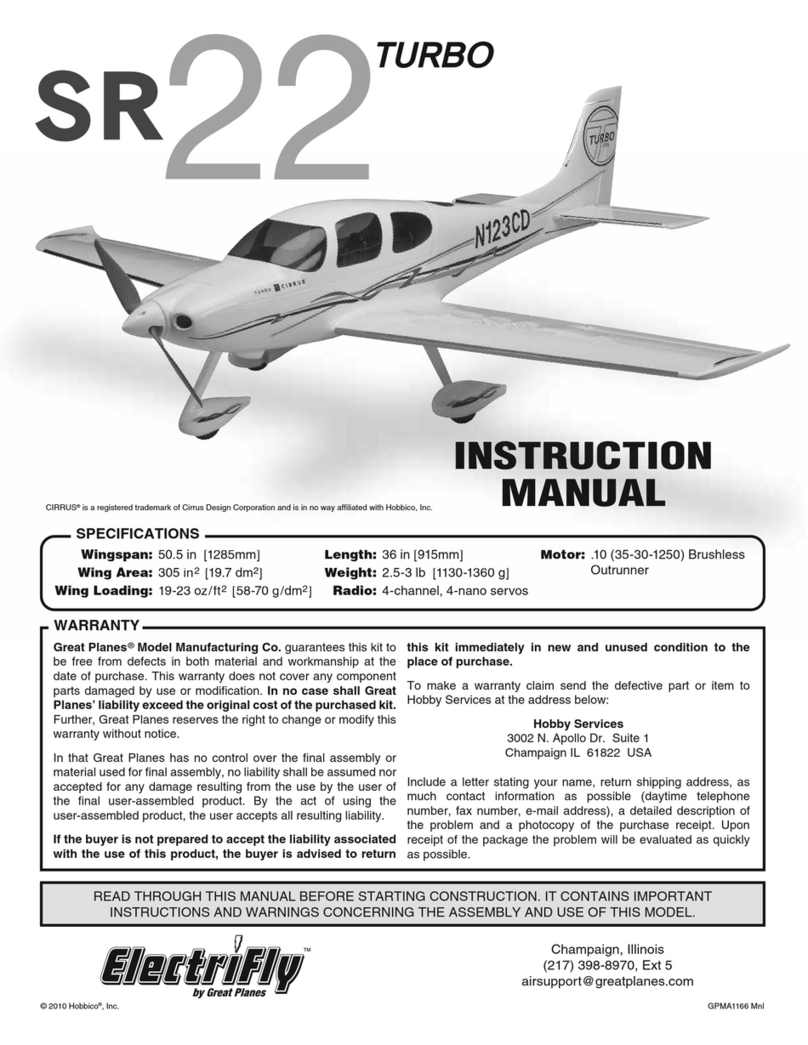
electrifly
electrifly SR22Turbo User manual
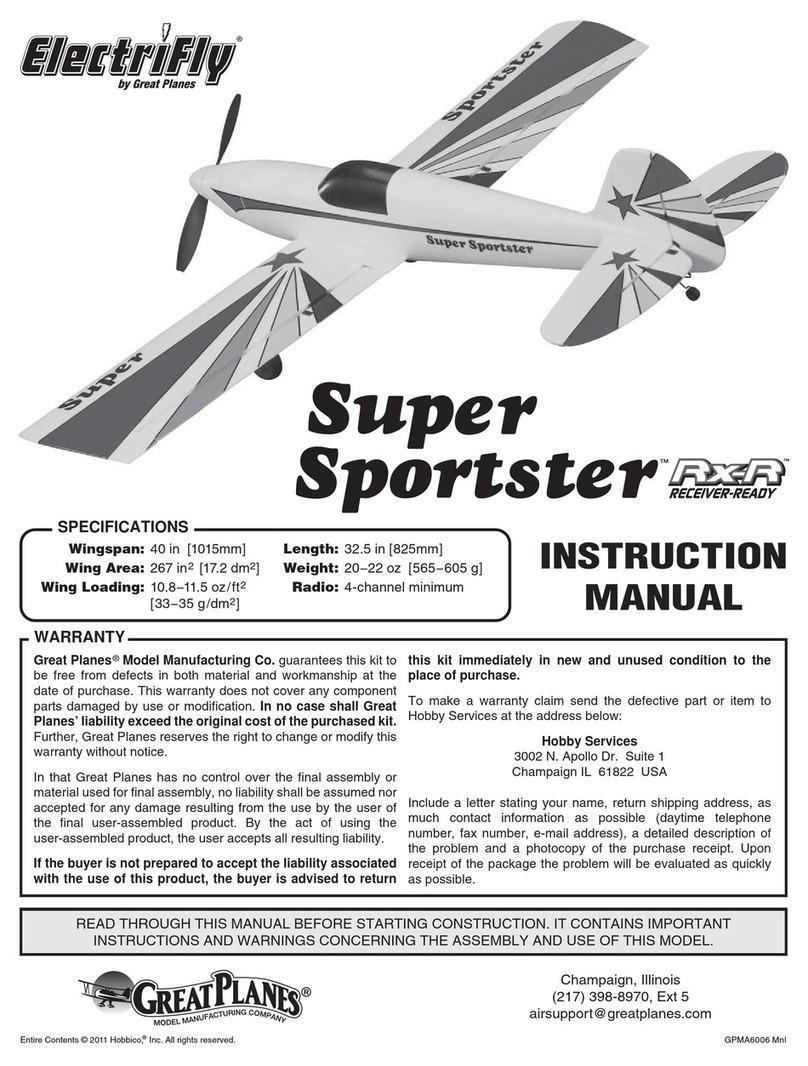
electrifly
electrifly Super Sportster RX-R User manual
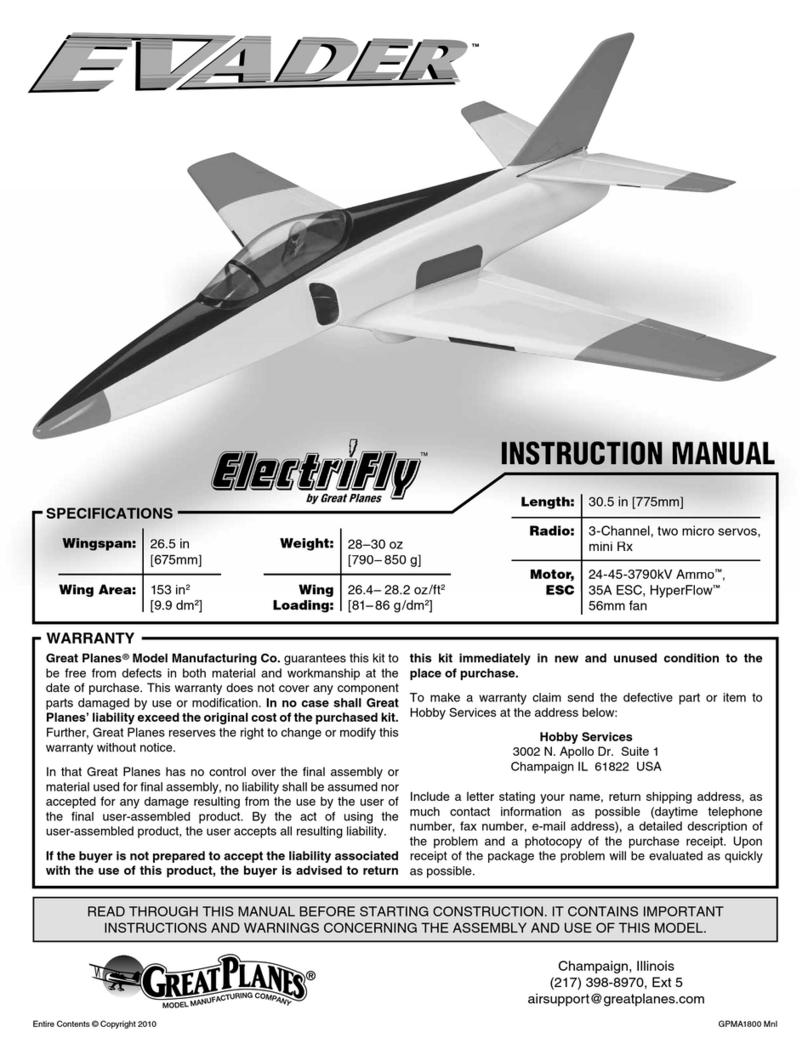
electrifly
electrifly ElectriFly User manual
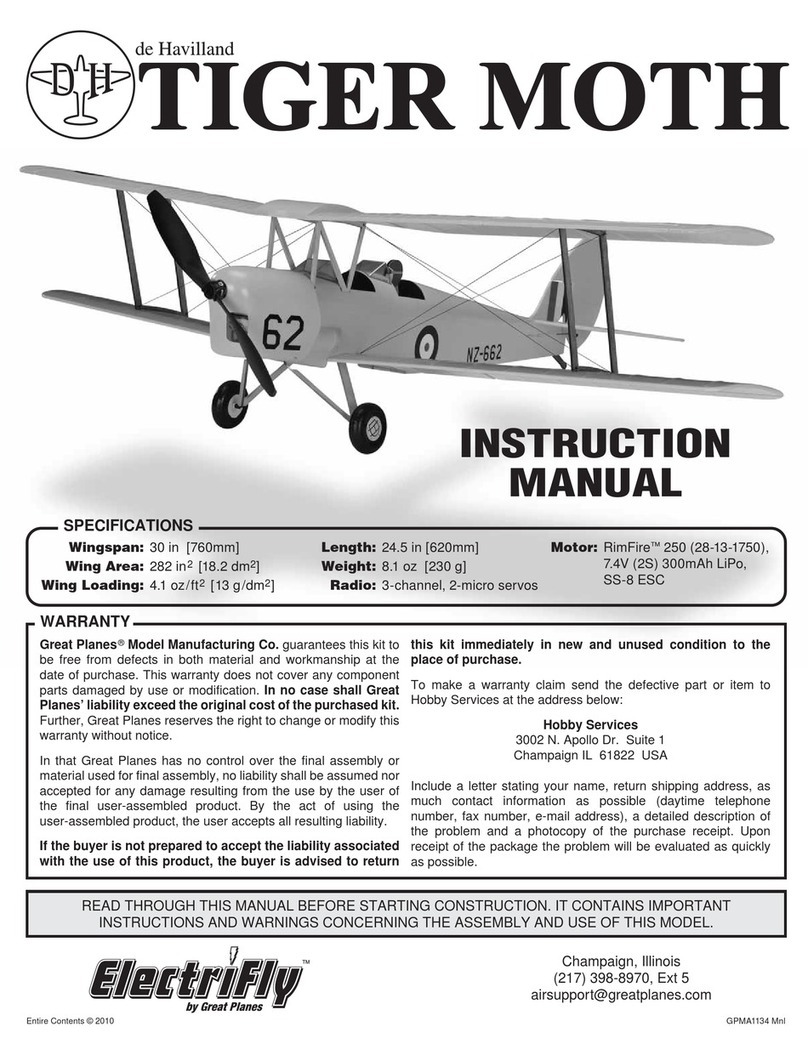
electrifly
electrifly Tiger Moth User manual
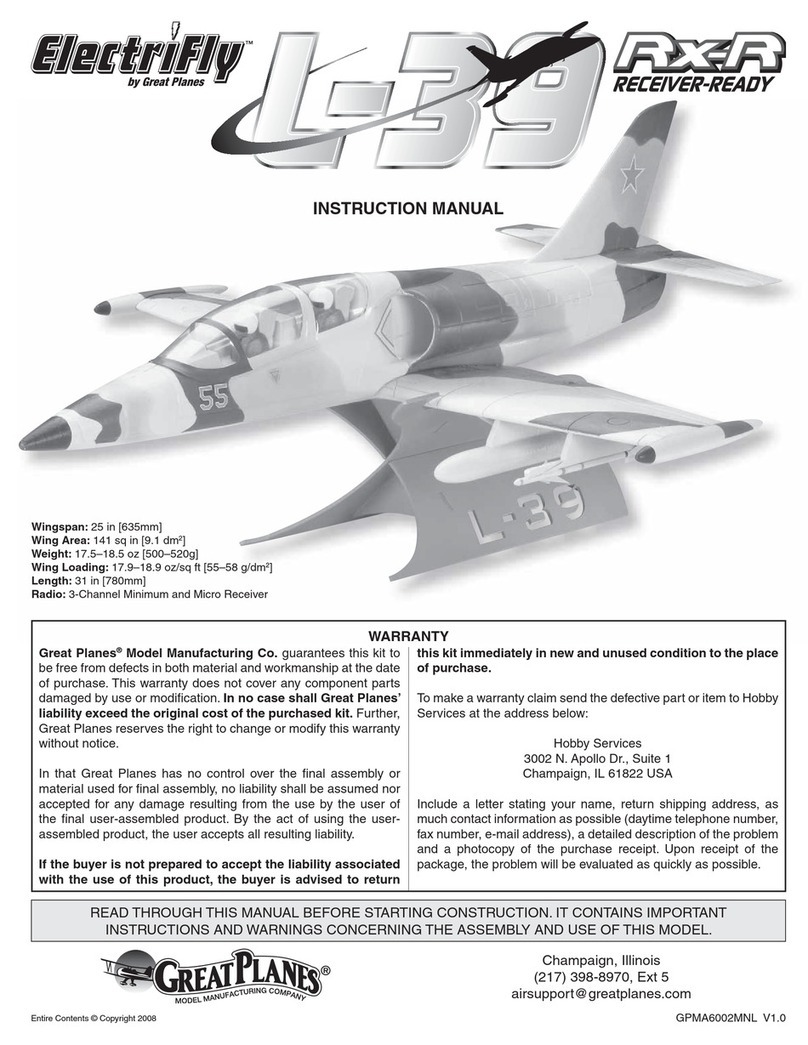
electrifly
electrifly L-39 User manual
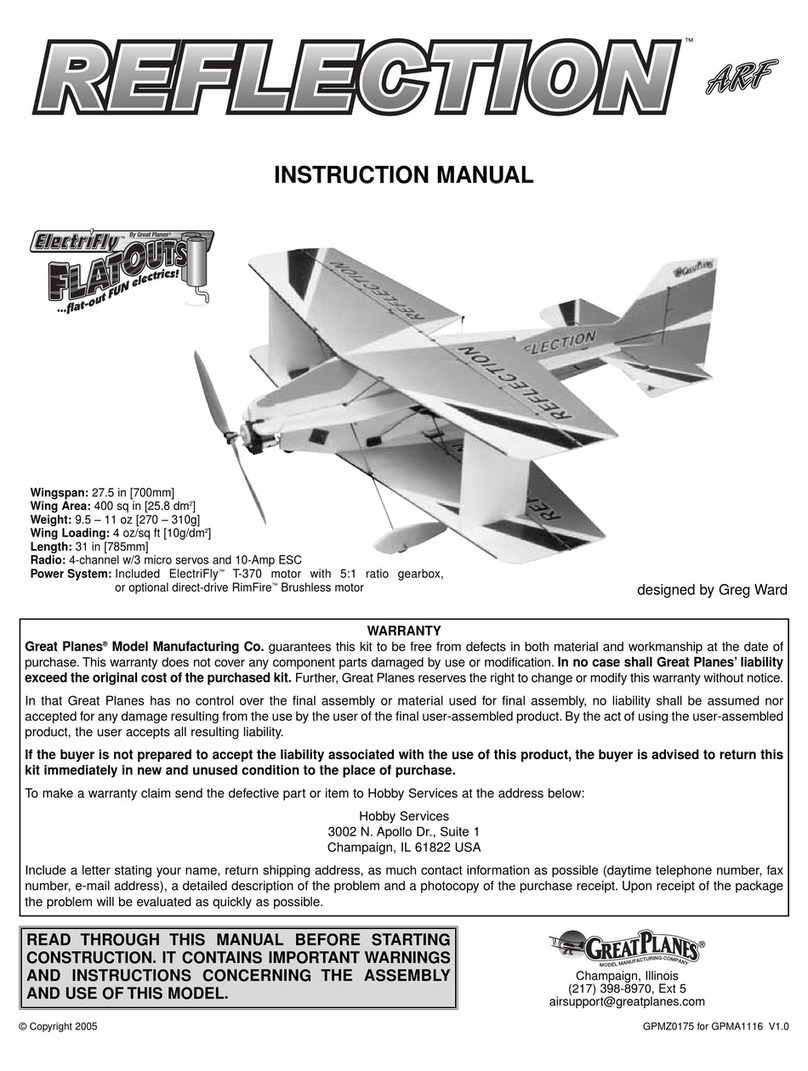
electrifly
electrifly reflection User manual
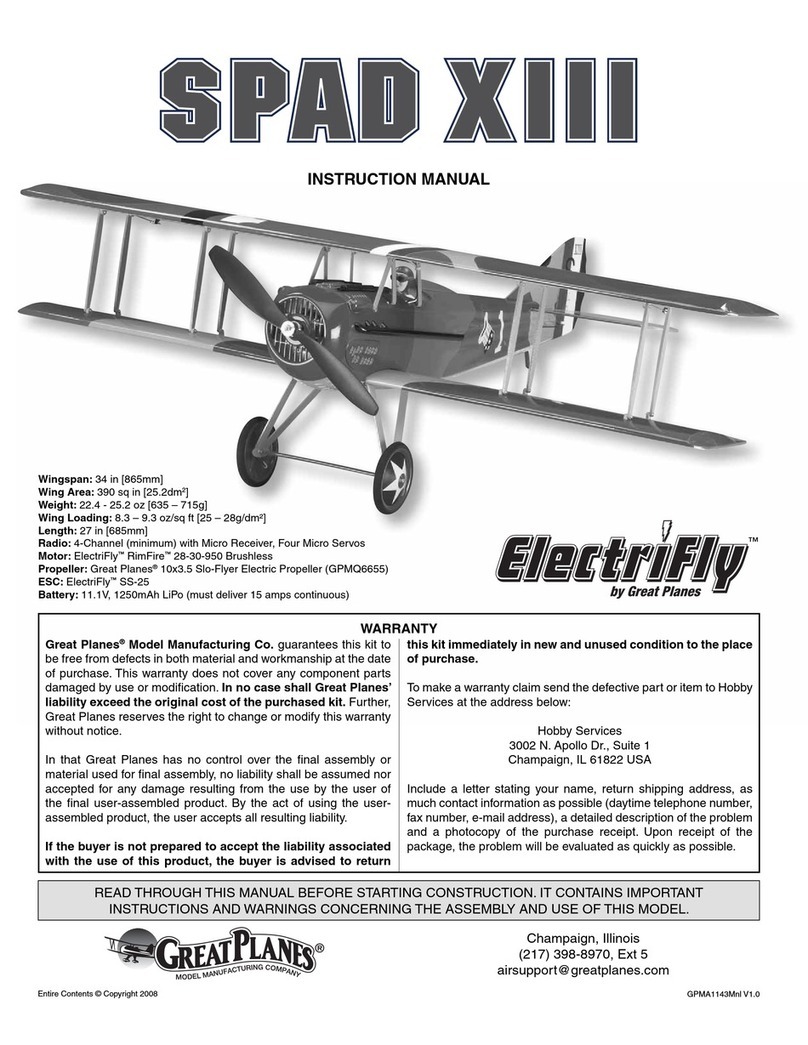
electrifly
electrifly Spad XIII User manual

